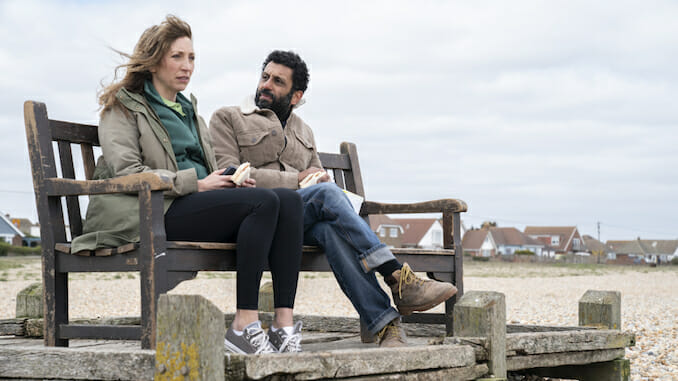Back to Life Season 2: Showtime’s Small and Shining Gem Requires Your Attention
Photo Courtesy of Showtime TV Reviews Back to Life
When writing a review of the delayed second season of a small, imported show that you’ve perhaps never heard of that’s airing on a premium network, it ends up being more of a plea. “It’s worth it!” I try and assure you. “Seek it out, you will be rewarded!” But it’s just so much easier to press play on any of the innumerable other options you have before you elsewhere. I understand. But…
You should watch Back to Life.
It’s a doubly-hard sell when the show is so small that it’s full second season is the length of a current blockbuster movie, yet it’s airing weekly. I’ve come around to the return of weekly release schedules, and many high-profile shows would benefit from it. But not Back to Life. It’s not that its episodes don’t end on cliffhanger moments or there isn’t a pull for you to return week after week, it’s that its richness is best experienced altogether as an immersive wave of emotion.
But anyway, one way or another, you should check out Back to Life.
Created by Daisy Haggard and Laura Solon, the BBC series (airing in the US on Showtime) revolves around a 30-something British woman, Miri (Haggard), who has just been released from an 18-year prison sentence for murder. The reality of the crime was that it was a tragic accident involving a friend, Laura, when Miri was still a teenager. It not only haunts her emotionally, it’s something her small town cannot move past. And yet, Haggard imbues Miri with a plucky and optimistic spirit, one that believes she can actually start living her life.
It sounds exceptionally heavy, but as I wrote in my review of Season 1, Back to Life is charming and wryly funny, a “soulful treasure.” The show shares that with Sundance TV’s excellent Rectify, which followed a similar storyline of a man coming out of solitary confinement after 19 years. But Back to Life is also very British in its sensibilities, and plays more for awkward laughs that help cut some of the most emotionally tense moments.
The first season’s six episodes took place in the weeks just after Miri’s release, and Season 2 picks up almost exactly where it left off. Important truths have been revealed regarding that fateful night, but the show focuses in more on Miri trying to move forward. And as we see, moving forward mostly means reverting back to her past self. Her life effectively stopped in 2000 when she was sent to prison, and so as Miri becomes more comfortable at home she returns to being a sulky teen. She hates her parents, picks out a Tamagotchi to carry with her every day, and crimps her hair. When her “friend” Mandy (it’s complicated) comments that her hair looks like a mermaid, Miri gives a quiet ”yessss” of satisfaction.
One of Season 1’s sweetest storylines was Miri’s budding relationship with Billy (Adeel Akhtar), a shy widower who lives next door and who is just as awkward and strange as Miri. Though they’re both fully adults, their relationship progresses, again, like their starting it all from scratch. Miri is terrified of intimacy because it’s been so long since she’s experienced it, and Billy is scared to open up again after having lost his wife. And so they share sandwiches on the beach and hang out and eventually cuddle. They’re simply there for one another, which is not a simple thing at all—but it is beautiful.
Season 2 also checks in again with Miri’s parents, Caroline (Geraldine James) and Oscar (Richard Durden), whose stories always feel tacked-on and yet are nevertheless delightful. Instead of dealing with his emotions over his wife’s infidelity, as revealed in the first season, Oscar is instead throwing himself into his environmental activism, leaving Caroline feeling bored and useless. But like all of the characters who orbit Miri—including her self-assured parole officer Janice (Jo Martin) and her bumbling pre-prison boyfriend Dom (Jamie Michie)—Caroline and Oscar get their own fully-formed worlds that afford them both losses and unique triumphs. Everything here is heightened for comedy, and yet it feels real enough to the spirit of small-town life and the awkward encounters and indignities faced, as well as the tiny, beautiful moments snatched in between.
I’ve gotten this far without mentioning a plot, because there really isn’t one. There are stakes that create a dark undercurrent throughout these six new episodes that revolve around Laura’s parents returning to town, but many of those elements feel half-baked or sensational compared to the rest of the season. It mostly leads to a satisfying conclusion, although that’s not entirely so for Christine Bottomley’s Mandy, who doesn’t get as much time as she deserves.
What really propels the series is simply a desire to see Miri navigate this “new” world and thrive. The show isn’t interested in her interacting with modern technology or understanding how the last two decades have shaped politics or global conflict. It’s very much focused on Miri simply allowing herself to be free, and learning what it means to live. It’s not made up of big, triumphant moments and crowds of cheering townsfolk. People mistrust her, many just don’t like her, things are frustrating and irritating and embarrassing. But she continues to move forward, to embrace every moment of it, because there’s finally cause for hope. And Miri, in her boundless optimism, clings as tightly to that as her beeping Tamagotchi.
Back to Life Season 2 premieres Monday, September 13th on Showtime.
Allison Keene is the TV Editor of Paste Magazine. For more television talk, pop culture chat and general japery, you can follow her @keeneTV
For all the latest TV news, reviews, lists and features, follow @Paste_TV.